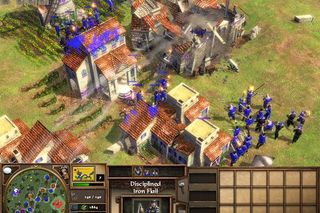12DOVE Verdict
Pros
- +
New civs mix up familiar gameplay
- +
Strategic options of new Export resource
- +
The return of Wonders
Cons
- -
Blah multiplayer additions
- -
New campaigns are a little brief
- -
Still AoE at heart
- -
if that's a drawback
Why you can trust 12DOVE
Nov 1, 2007
After two years on shelves, Age of Empires III was beginning to look like it was locked in predictability. So The Asian Dynasties expansion from developer Big Huge Games (best known for creating Rise of Nations) arrives at just the right time, like new menus showing up at your favorite Chinese place just when you're getting sick of the same old sweet-and-sour chicken balls. New civilizations that play unlike any of their predecessors, a host of revamped features, and a return to AoE's past with the revival of Wonders spice up the core gameplay in a much-needed way.

As expected from the title, Asian Dynasties moves the focus of the RTS series from the European settlement of the New World to the Far East. So say a sad sayonara to the Cherokee and Aztecs and a sunny konichi-wa to the Japanese, Chinese, and Indians. Each new civ is represented in three abbreviated five-scenario campaigns telling the story of the Japanese shogunate in the 16th century, a Chinese fleet that discovers the west coast of North America in the early 15th century (don't laugh - the 1421 theory is pretty popular these days), and the Indian rebellion against the British in the 19th century. The new civs are more than fresh faces, too, although they also look a lot different than their European and Native American rivals thanks to unique visuals. You certainly haven't seen the likes of the Chinese flying crow, Japanese samurai, and Taj Mahal-like Indian temples elsewhere in the AoE III series.
Playing any one of this trio is like learning a whole new game. The Japanese have quasi-mystical shrines that summon animals for food and mobile armies based around daimyo generals able to receive home-city shipments and train soldiers. Indians buy villagers with wood instead of food and send huge elephants into the field of battle. And the Chinese field whole mixed-unit armies through the War Academy building, which really helps when you need to fight fast.
More info
| Genre | Strategy |
| Description | While the core gameplay is still recognizable, this is a great facelift that makes an old friend look young again. |
| Platform | "PC" |
| US censor rating | "Teen" |
| UK censor rating | "" |
| Alternative names | "AoE" |
| Release date | 1 January 1970 (US), 1 January 1970 (UK) |

GameSir Cyclone 2 review: “The checklist this brand has built a reputation on”

Assassin's Creed Shadows director says the dreaded yellow paint was only added because "players were really struggling in playtests"

Following "mistaken" DMCA from D&D publisher Wizards of the Coast, Stardew Valley player behind Larian-approved Baldur's Gate 3 mod assures work will "resume as scheduled"










